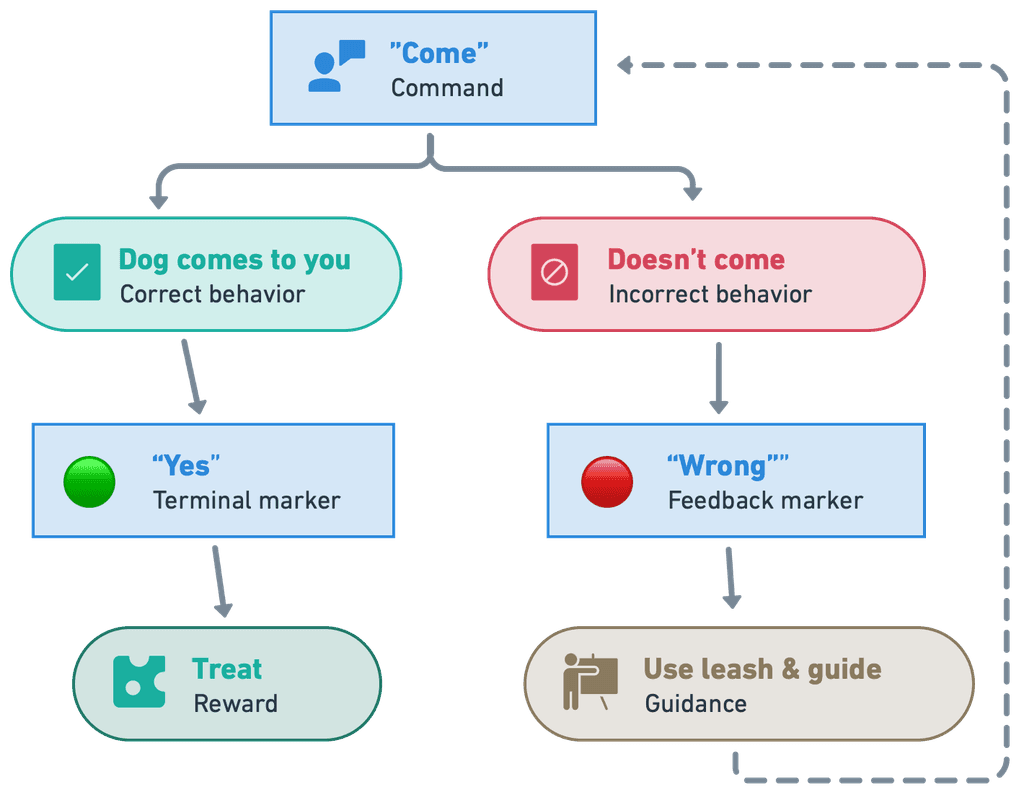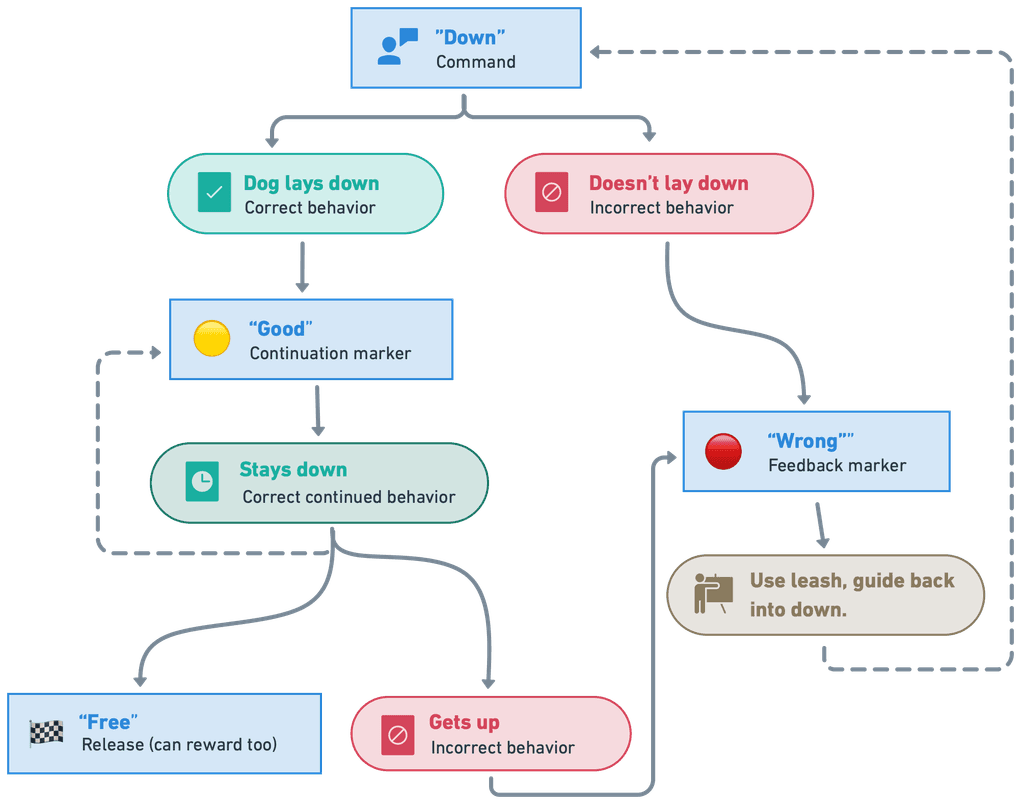In this lesson we'll continue with the "place" command and turn it into a sustained behavior. Once we tell them to place, they need to stay in their place. We'll learn a couple new markers ("Good" and "Wrong") and introduce a release word ("Free"). We'll also revisit "Sit" and "Down" to turn those into sustained behaviors.
This lesson is a little technical but don't be intimidated. In practice it's easier than it looks.
Before we start the exercises we need to learn and practice three new words: "Good" "Wrong" and "Free." Knowing when to say them to your dog is important. If all these flowcharts is raising your blood pressure a bit, skip down to THE BIGGER PICTURE section at the bottom of this page. That's the vision for what we're after here. This may feel clunky at first but it'll feel natural later.
These 2 new words need to be at the tip of your tongue ready to go. Each is said in immediate response to what your dog does.
🟢 "Yes" (Terminal Marker)
The terminal marker predicts an immediate reward. It means "You did it! All done." This is our standard marker we learned way back in lesson 1! You've said it a thousand times by now. It's technically known as the "terminal" marker because it marks the end of the action.
🟡 "Good" (Continuation Marker)
The continuation marker predicts an eventual reward. It means "You did it, but keep doing it!" This marker tells them they're on the right track but we're not finished yet. It's an encouragement to continue the behavior, whether that behavior sitting, staying, or heeling.
🔴 "Wrong" (Feedback Marker)
The feedback marker predicts immediate guidance. It means "Nope, that wasn't it but don't worry I'll show you." Just like our other markers, the power lies in the precision. "Wrong" lets them know that the thing they just did, right then, was the wrong thing. It's immediately followed with help, typically using the leash. Say this marker with without any stress or emotion in your voice.
IMPORTANT: "Wrong" predicts guidance not punishment. Remember that during the learning phase, punishment is unfair, confusing to your dog, and slows down their learning.
⚠️ "No" (Correction Marker)
We're not using this today because we're teaching something new to your dog. But once your dog fully understands a command by passing through all 3 phases of learning then you can start to use a correction marker.
A correction marker can only be used when 1) you have your dog's focus 2) they're not over their emotional threshold and 3) they've demonstrated over and over again that they can perform what you've commanded in different environments. Only then are they appropriate and meaningful.
In lesson 1 we learned that "yes" must predict an immediate reward for the word to have any meaning to your dog. "No" works the same way with punishment–typically a pop on the collar, a sound they don't like, a buzz on the remote vibrate collar, or a low level tap on the e-collar.
Learn: Marker Usage for a Momentary Behavior
Many of the things we ask our dogs to do are quick, momentary behaviors. Once the dog does the behavior they're done. This includes things like:
Come – Once they land at your feet, the job is done.
Shake – Once they offer their paw for a hand shake, the job is done.
Hop up – Once they hop up on the bench or the back seat for the car, the job is done.
Jump – Once they jump over the object, that's it.
Rollover – After they rollover, that's it!
Drop it – Once they drop it, that's it. (See "Leave it" below)
For these things, we use the terminal marker "Yes" when they completed the task and "Wrong" if they get it wrong or don't respond.
For each arrow you see the maximum elapsed time is 2 seconds. Remember that for dogs, feedback must be nearly immediate so they understand the cause and effect of each event. So, the moment you say "Come" then 2 seconds later you're going to say "Yes" or "Wrong" depending on what your dog does.
Learn: Release Word 🏁 "Free"
Performing a sustained behavior like "heel" or "down" is particularly hard for energetic dogs and younger dogs. If you use a release word, they'll typically perform these sustained behaviors more reliably because they understand–this isn't forever.
I use the word "Free." Some trainers use "Break." The idea is the same. When you hear this sound, you're released from command. In this case, it means you can hop off that platform if you want.
Learn: Marker Usage and Release for a Sustained Behavior
Many of the things we ask our dogs to do are sustained behaviors. Once they start the behavior we want to them to automatically keep doing it. This includes things like:
Sit – Once your dog is sitting, they need to keep sitting until released. Otherwise "sit" just means touch-your-butt-to-the-ground.
Down – One your dog is down, the "stay" is implied. We're not doing to stare at them and say "stay staaaaaay staaaaaaaay." This ain't Petco dog training.
Heel – Obviously if your dog just walks away then they're not heeling.
Leave it – If you tell your dog to leave something/someone alone then they need to continue leaving it alone.
For these kinds of behaviors we need the two new tools we learned earlier:
🟡 Continuation marker "Good…" – This just lets the dog know they need.
🏁 Release word "Free" – All done! Go be a dog. Some trainers use "Break!"
Here's what the entire behavior lifecycle looks for sustained behaviors:
Whew! What a flowchart. It might seem like overkill but consider the alternatives:
Your dog never learns that sit, down, leave-it, and heel are sustained behaviors. "Down" just means lay down till you feel like popping up. "Heel" means stick by me… unless you don't want to.
Your dog sloooowly learns these sustained behaviors through inference and lots of relationship-degrading frustration.
I don't know about you but if I'm sitting at a cafe with my dog at my feet, I want to say "down" once and know they'll stay there. If my dog is barking at the door and I say "place" I want them to head over to their place and stay there without having to say "staaaaaay staaaaay" like a total goober.
Exercise: "Place" with the Implied Stay
Keep the leash on your dog and let them drag it around. That way you're ready to provide guidance back to the platform when they leave the platform. Remember, they will leave the platform because they don't know any better yet.
Tell them to "Place" which, they should know by now. If they don't immediately go over to the platform then we're not ready for this lesson and we need to go back to lesson 4 to keep teaching what "place" means.
Once on their the platform, you should issue give them the continuation marker 🟡 "Good" and reward.
As soon as they step one paw off the platform, issue the feedback marker 🔴 "Wrong" and take the leash and guide them immediately back onto the platform. Do not immediately reward when they get back to the platform.
Count to five. If they're still on the platform, issue the continuation marker 🟡 "Good" again and reward.
If they make it to another 5 seconds on the platform, issue your release word 🏁 "Free" and toss a treat away from the platform to encourage them to step off.
TIPS AND TRICKS
☝️
The continuation marker ("Good…") and the release word ("Free") will take a while for your dog to generalize. Unlike the terminal marker ("Yes") we can't really condition a dog to the sound using mealtime like we did in lesson 1. Be patient, keep at it, and they'll eventually understand the meaning of both.
☝️
Be careful with your words! Some people just can't help themselves and they'll say "stay" because we've seen people telling dogs to stay our whole lives. We're teaching an implied stay with our "Place" command.
☝️
Some dogs want to immediately jump off the platform and run to you. In the beginning, to get them to stay on it, you may need to stand directly next to the platform to leave almost no space for them to get off. You can also use your body to create "spatial pressure" (crowding them back onto the platform).
☝️
"Wrong" should be neutral in tone. Remember it's not a negative thing, it's just a marker for feedback. In your mind think "Nope, that wasn't it. Here' I'll show ya." That's all we mean when we use the feedback marker.
☝️
Some dogs LOVE their platform and will happily get on it and stay there. It's a doggy hammock after all! You need them to get back off it though so you can get the reps for the "Place" command. Show them you have some high-value rewards (like cheese) in your hand and maybe even toss some away from the platform to get them off it. Do this immediately after you say "Free."
At some point they will start to understand that staying on the platform is implied when you tell them to "place."
Exercise: "Sit" and "Down" with the Implied Stay
This is practiced the exact same way as the "Place" with the implied stay.
Once your dog sits, they need to stay sitting. If they get up or lay down, then calmly say "wrong" and use the leash to guide them back into position. Same thing with "down".
Increasing the Difficulty
Once your dog understands what an implied "stay" is, you can start increasing the difficulty with the three D's:
Distance
When asking your dog to "place" or "sit" or "down" take a few steps away from them. Many dogs take your movement away from them as a queue that we're done and we're moving onto something else. Nope! You stepping away from your dog doesn't mean they can break what they were doing.
Distraction
When asking for a sustained behavior, try making fun noises and acting engaging. If your dog pops up from their down or steps off the platform from a "place" then calmly say "wrong" and put them back into position. Another form of distraction is an engaging environment. If they're rock solid with the "place" command at home in the living room, try moving the platform to the front yard.
Duration
Ask them to "place" for 10 seconds. Then 30 seconds. Then a minute. Then 5. Then 20. Then 30.








